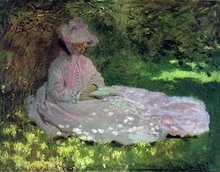So, yeah, this book was a wee bit tedious to go through, even though the whole time I read it I thought, Man, this is an AWESOME translation! As has been pointed out, it is gorgeous in description and he's very eloquent and that clearly comes across in English, but I think I use the words "wee bit" charitably because it took me forever to get through this book, as my interest often waned.
In fact, I finished the book and was like, Okay, I should really post while it's fresh in my mind, but alas! I didn't and I returned it to the library. Then, today, as everyone else's reviews popped up in my inbox, I was like, "I don't even remember how to spell the author's name!" So, I went to Amazon and lo and behold, here was this very interesting bit from the author himself (sorry for the cut & paste):
"Years ago, when I began working on my fifth novel, The Shadow of the Wind, I started toying around with the idea of creating a fictional universe that would be articulated through four interconnected stories in which we would meet some of the same characters at different times in their lives, and see them from different perspectives where many plots and subplots would tie around in knots for the reader to untie. It sounds somewhat pretentious, but my idea was to add a twist to the story and provide the reader with what I hoped would be a stimulating and playful reading experience. Since these books were, in part, about the world of literature, books, reading and language, I thought it would be interesting to use the different novels to explore those themes through different angles and to add new layers to the meaning of the stories.
"At first I thought this could be done in one book, but soon I realized it would make Shadow of the Wind a monster novel, and in many ways, destroy the structure I was trying to design for it. I realized I would have to write four different novels. They would be stand-alone stories that could be read in any order. I saw them as a Chinese box of stories with four doors of entry, a labyrinth of fictions that could be explored in many directions, entirely or in parts, and that could provide the reader with an additional layer of enjoyment and play. These novels would have a central axis, the idea of the Cemetery of Forgotten Books, set against the backdrop of a highly stylized, gothic and mysterious Barcelona. Since each novel was going to be complex and difficult to write, I decided to take one at a time and see how the experiment evolved on its own in an organic way.
"It all sounds very complicated, but it is not. At the end of the day, these are just stories that share a universe, a tone and some central themes and characters. You don’t need to care or know about any of this stuff to enjoy them. One of the fun things about this process was it allowed me to give each book a different personality. Thus, if Shadow of the Wind is the nice, good girl in the family, The Angel’s Game would be the wicked gothic stepsister. Some readers often ask me if The Angel’s Game is a prequel or a sequel. The answer is: none of these things, and all of the above. Essentially The Angel’s Game is a new book, a stand-alone story that you can fully enjoy and understand on its own. But if you have already read The Shadow of the Wind, or you decide to read it afterwards, you’ll find new meanings and connections that I hope will enhance your experience with these characters and their adventures.
"The Angel’s Game has many games inside, one of them with the reader. It is a book designed to make you step into the storytelling process and become a part of it. In other words, the wicked, gothic chick wants your blood. Beware. Maybe, without realizing, I ended up writing a monster book after all... Don’t say I didn’t warn you, courageous reader. I’ll see you on the other side". --Carlos Ruiz Zafón
...and I thought, "Wow! That is fascinating." My very favorite part of the book were the visits to the Cemetary of Forgotten Books, because truly books affect our lives in different ways at different times when we read them, and how fascinating is it to think of a place where ALL books dwell.
Anyway! While not my FAVORITE book, I kinda like it better after reading about how it fits together as part of a plan by the author.
Katie, thanks for giving us an opportunity to read a very different type of book. :)

1 comment:
That is an interesting interview(?) with the author, although the only connection I made between the two books was the Cemetery of Forgotten Books - I was happy to see that come up again.
And thanks for pointing out the fact that the translation is awesome. It's one thing to be descriptive and eloquent in your own language, but to translate another language and have it be also beautiful, that's a talent.
Post a Comment